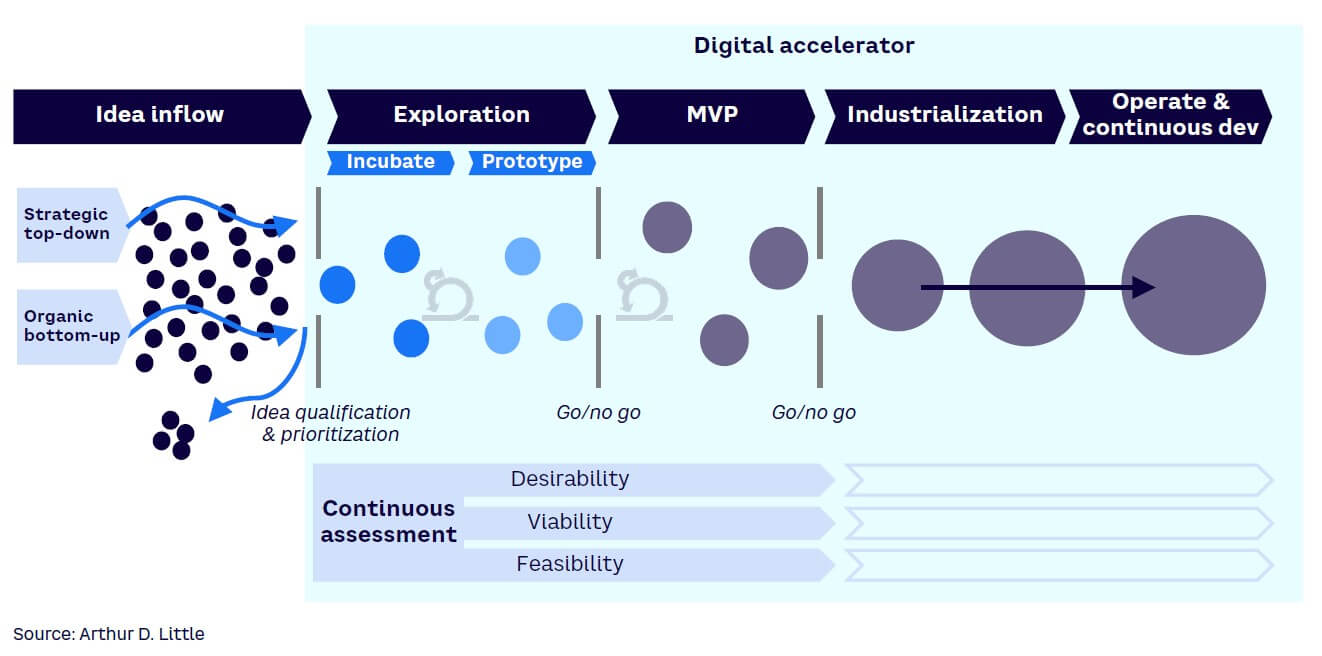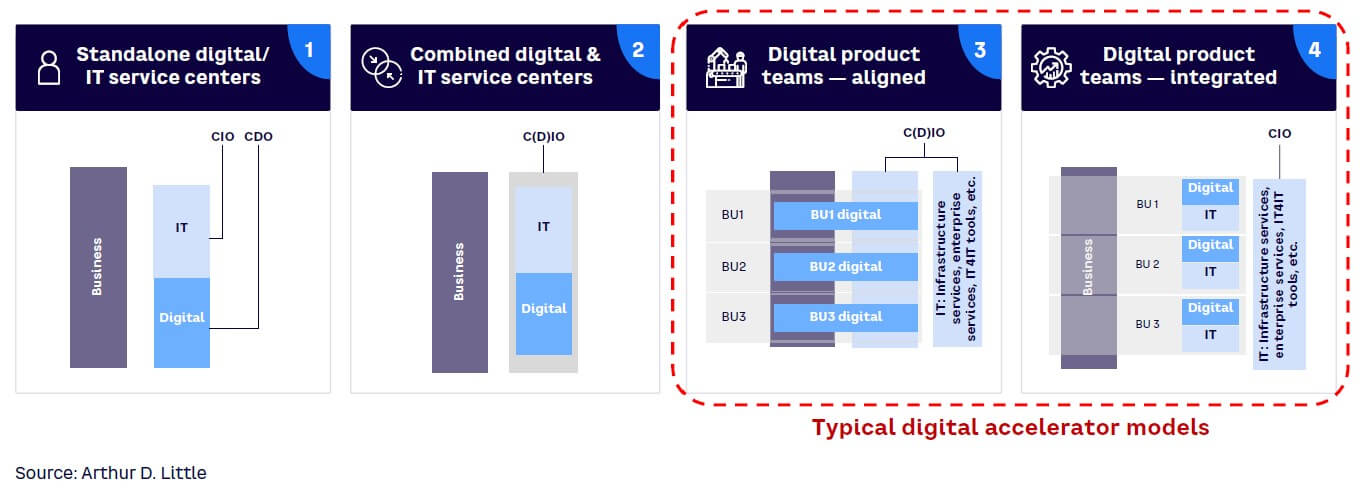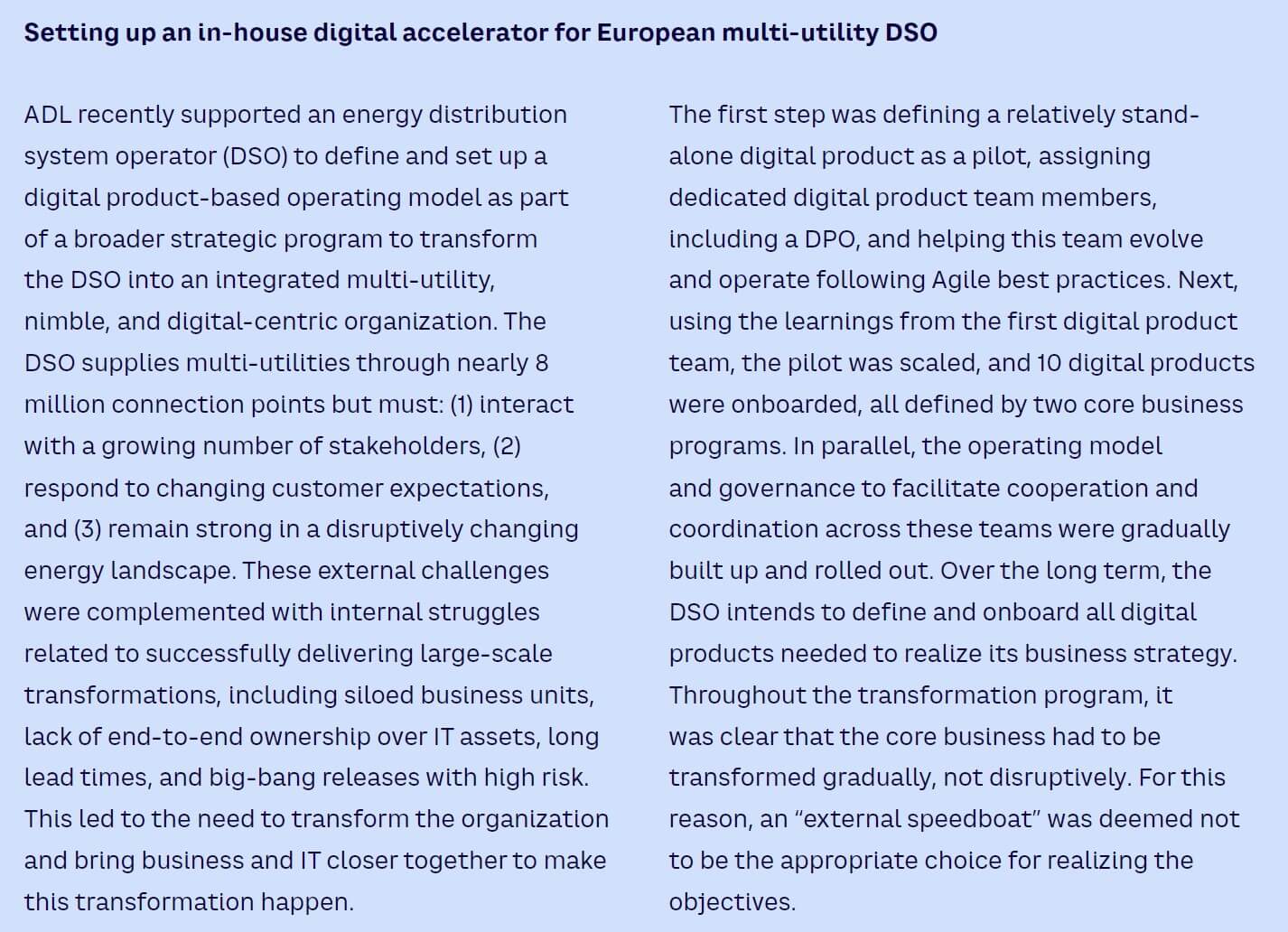
Software is becoming part of the core business for a growing number of enterprises, with ever-evolving artificial intelligence (AI) technology further boosting this trend. For this reason, traditional digital and IT organizational models that involve outsourced/remote digital factories, or accelerators, are becoming less suitable. However, bringing software development in-house is not a straightforward assignment. In this Viewpoint, we address setting up an in-house accelerator that maintains innovativeness and agility while driving digital transformation of the core business.
THE SOFTWARIZATION OF COMPANIES
Over the last decade, software really has started “eating the world” as Marc Andreessen famously predicted in 2011. While digital transformation of industry has not been without its challenges — and there is still a long way to go — progress is now accelerating. According to data from Arthur D. Little (ADL), Gartner, and Statista, global spending on digital transformation technologies and services increased by over 90% to US $1.8 trillion in the last five years leading up to 2022. A 2022 Gartner survey of CEOs and senior business executives showed digital and IT capabilities as the top investment priority above everything else. For some industries, such as automotive manufacturing, the digitalization journey is already well advanced, with OEMs investing massively in software design capabilities and recruiting thousands of software engineers — as Herbert Diess, former CEO of Volkswagen Group put it, “Software competence is the only way forward.”
Digital technologies are playing an increasingly central role in manufacturing, particularly in areas such as plant operation and product design, as well as in healthcare, specifically in drug development and medical technology. Furthermore, even across more asset-intensive industries, such as chemicals, energy, and transportation, digitalization has become an essential tool in asset and operations management.
Plus, the recent rapid advances in AI are turbocharging this trend. Accessible and cost-effective, AI is a key enabler for managing the vast amounts of data involved in effective digitalization of connected assets, processes, and products. Moreover, the widespread availability of cloud computing capacity and low-cost, high-performance computing power is reducing investment barriers. New generations of data and analytics tools, along with access to multiple open source capabilities as well as data to train AI models, are greatly reducing the obstacles for adoption.
This means that software development has moved from a specialist support service to a key strategic capability at the core of the business. This change has some profound implications for businesses in terms of capability building. What is the best way to go about structuring and organizing a corporate software development function, and what factors should companies consider to ensure success?
HOW COMPANIES HAVE DEALT WITH SOFTWARE DEVELOPMENT
In general, digital functions have become increasingly integrated across the business with the progression of digital transformation. That said, there are various organizational model stereotypes today. At one end of the scale, some companies prefer a centralized digital hub/service center separate from business and IT, but that can cater to both IT and the various business units. TotalEnergies and Thales are two typical examples of organizations that use such a centralized hub or service center.
In other cases, traditional and digital IT services are combined into a single hub that serves the business. Many companies have created chief digital officer (CDO) roles to infuse digitalization throughout the organization, sometimes referred to as a “tea bag” role as it aims to diffuse and make itself obsolete in the long run. Greater business alignment is achieved often by embedding product owners from the business units into the digital hub. Ultimately, digital and IT services may be embedded fully into each business unit with close collaboration across business, digital, and IT in cross-functional product teams, having just an enabling platform and infrastructure services retained at the center.
Whatever the model, traditionally the most common approach to access new software has been to buy rather than make where possible, for reasons of cost, ease of support, and reliability. If the business requires new software not readily available off the shelf, development is outsourced to the vendor or other specialist service provider. Alternatively, it could be co-sourced within a project organization with a resource mix between external and internal software engineers, which would facilitate fluidity in sharing both technological expertise and corporate-specific experience. Speed and agility are some of the main benefits of creating new software development outside of traditional corporate boundaries — hence, the often-used analogy of the “speedboat,” in contrast to the slower-moving corporate “mothership.” However, as software becomes increasingly core to the business, the drawbacks of the speedboat model become increasingly significant. For example:
-
Technology misalignment. Speedboats are intentionally meant to have freedom to develop the best solution as quickly as possible without corporate interference. However, over time this can increase the heterogeneity of the technology stack, storing up process and data integration problems and incurring future additional costs.
-
Lack of capability building. Speedboats have little or no lasting impact on in-house software capability building, relying instead on external expertise and maintaining dependence on third parties whose standard offerings make differentiation hard to achieve.
-
Low impact on core business. Speedboats have limited positive spin-off or flywheel effects on the core business in terms of driving further digitalization, enhancing customer experience and upsell through digital, helping shift ingrained cultures, and/or accelerating time to deployment.
In summary, the speedboat model works well when the emphasis is on cost and speed or when software is peripheral to the business and needs to create a specific branding (i.e., to attract talent). However, it is poor at helping to drive digital transformation and create longer-term business value when software has become core to the business.
BRINGING THE SPEEDBOAT IN-HOUSE
Companies have therefore increasingly invested in building in-house software development capabilities, often referred to as “digital factories.” We refer to them here as digital accelerators to avoid any confusion with physical factories and stress the importance of both “build” and “run” inside these accelerators. An in-house digital accelerator aims to bring together the right capabilities in one place to identify, explore, develop, launch, industrialize, and maintain new software platforms and solutions (see Figure 1).

While the overall process is fairly clear, it is less obvious how best to set up the structure and operating model for a digital accelerator within a large corporation. To properly drive business value, create a competitive advantage, and act as a transformation catalyst, accelerators must meet a range of needs. They should:
-
Accelerate innovation speed from proof of concept to deployment stages.
-
Promote synergies across business lines and factories through common platforms and solutions.
-
Drive transformation through progressively taking over legacy IT.
-
Shift culture by adopting and diffusing new attitudes and ways of working.
-
Enhance brand image through demonstrating innovativeness and responsiveness.
Inevitably, this means that organizations must strike the right balances across dimensions such as autonomy versus dependency, integration versus centralization, and creativity versus efficiency. Based on our experience in supporting large companies in setting up and managing in-house digital accelerators, we recommend the following approach.
1. Be clear about intent, ambition & scope
The nature of the strategic intent will have a significant impact on accelerator setup. For example, greater organizational integration is preferred when the intent is to transform the core business rather than to develop new businesses from scratch.
Similarly, accelerators may focus on one or multiple technologies and be required to service one or multiple businesses. In some cases, accelerators will have several goals, both for the company overall and for different business units. The greater the clarity of the goals, the easier it is to define the right structure and operating model. In addition, setting the right scope for the accelerator is crucial to define its organizational boundaries. Typically, organizations restrict accelerators to the “change” part of the organization, excluding the operations that deal with the day-to-day running of the business.
2. Consider all operating model elements
Companies sometimes become overly fixated on organizational design while paying insufficient attention to other elements of the operating model. These other essential elements include budget and funding, processes, enabling technologies, culture and ways of working, metrics, resource allocation (financial and human), and governance (see point 5 below). For example, one important issue is how to source the right people for integration into the back-end systems. Can capacity be prioritized on the IT side to support and join the digital accelerator, or should external staffing or recruitment be considered? Will the entity be a cost center or a profit center? How should specific roles be allocated across, respectively, the digital accelerator, shared IT, and the business units?
3. Select the right organizational model
Generally, digital accelerators require an organizational model that enables good alignment with the core businesses (see Figure 2).

The need for core business alignment means that models involving separate corporate digital and IT service centers (options 1 and 2 in Figure 2) are usually less appropriate, unless the sole intent of the digital accelerator is to develop new standalone digital products for new businesses that don’t already exist.
A more common approach is, therefore, to set up digital product teams — multifunctional teams with business and IT roles, including software developers — to create a combined complementary skill set that answers to the needs of the digital product, under the leadership of a digital product owner (DPO). The DPO is responsible for defining the product vision, managing the product in line with customer needs, and setting priorities with the team. In general, teams should be largely self-sufficient and independent from each other to ensure speed and agility.
As shown in Figure 2, digital product teams can either be embedded in a central digital/IT hub, but aligned with individual businesses (option 3), or fully integrated within the individual businesses, with only platform and infrastructure services retained centrally (option 4).
Option 3, in which digital product teams are embedded centrally, is clearly more appropriate for settings where driving cross–business unit synergies and ensuring consistent digital transformation approaches are top priority. It enables stronger central leadership, enhances cross-business learning, and offers scale and cost-efficiency advantages. On the downside, it may lead to weaker business unit ownership, more distance from the customer, and conflicts in cross-business priorities.
Option 4, where digital product teams are fully integrated within individual businesses, is a better solution when the most important priority is digital integration into the core. It promotes ownership and buy-in from business leadership and helps product teams obtain a deeper understanding of the context and specifics of each business. Its downsides include potential inefficiencies, complications with managing cross-business interdependencies, and more difficulty in driving enterprise-wide objectives.
Hybrid solutions are also possible. Here, some digital products are centrally organized while others are positioned within the businesses. The choice of model will ultimately depend on the strategic intent and a range of other factors, including the dynamics and status of each business; the prevailing stages of evolution along the digitalization journey; and the structure, history, and culture of the organization.
4. Identify & structure the right digital products
In conjunction with defining the right organizational setup, it is crucial to identify and design the right granularity of digital products to function as nimble building blocks of the digital accelerator. Cross-functional teams are important to improve alignment with customer or business perspectives and to create self-sufficient teams. Digital products typically align to a logical set of IT components (e.g., applications, data, interfaces) that can evolve and be managed autonomously, delivering valuable business functionalities or technical abilities and/or foundations. To achieve this, digital products should:
-
Deliver business or technical value on their own and be able to manage “run, grow, and transform” for the scope of the product.
-
Limit dependencies on other products.
-
Have clear ownership within the organization.
-
Ensure clarity on how the product contributes to the end-to-end valuestream toward a customer or end user.
5. Put appropriate governance in place
Establishing the right governance over the digital accelerator and its operating processes is especially important, given the balances required between potentially conflicting objectives. The governance approach should, in particular, ensure that the respective interests and positions of digital, innovation, IT, and business functions are represented and centered around the following key actions:
-
Establish product ambitions, roadmaps, and priorities in and across products.
-
Set clear requirements and criteria for entry into the funnel and staged development milestones and criteria to scale further, pivot, discontinue, and so on.
-
Manage interface issues between functions and businesses, arbitrating on product and resourcing priorities, and resolving conflicts.
-
Establish clear rules for how the accelerator works with, and gradually transforms, the legacy IT backend.
-
Clarify responsibilities for running and maintaining new products delivered by the accelerator.
Conclusion
CREATING A SUCCESSFUL DIGITAL ACCELERATOR
Digital accelerators are increasingly necessary as companies progress on their digital transformation journey. Setting up and organizing digital accelerators effectively requires a careful, structured approach:
-
Translate the context and intent of the accelerator into criteria to assess structure and operating model options.
-
Strike a balance between providing autonomy and freedom for speed and agility versus integration within the business, to ensure alignment and proximity to the customer.
-
Make accelerator teams cross-functional, including software developers and business and IT specialists, to minimize interdepencies.
-
Consider the end-to-end innovation cycle to ensure that the accelerator maintains some accountability for operation and maintenance of new digital products.
-
Implement effective governance arrangements to make decisions, balance priorities, and resolve conflicts.
-
Provide early clarity on the scope and distribution of roles between business units, especially IT.
-
Communicate clear expectations to employees about the new ways of working and support them in the transition.
-
Continue working on an employee value proposition to attract and retain the best talent.
-
Implement the right KPIs to reach digital accelerator aspirations (i.e., speed and innovation).




